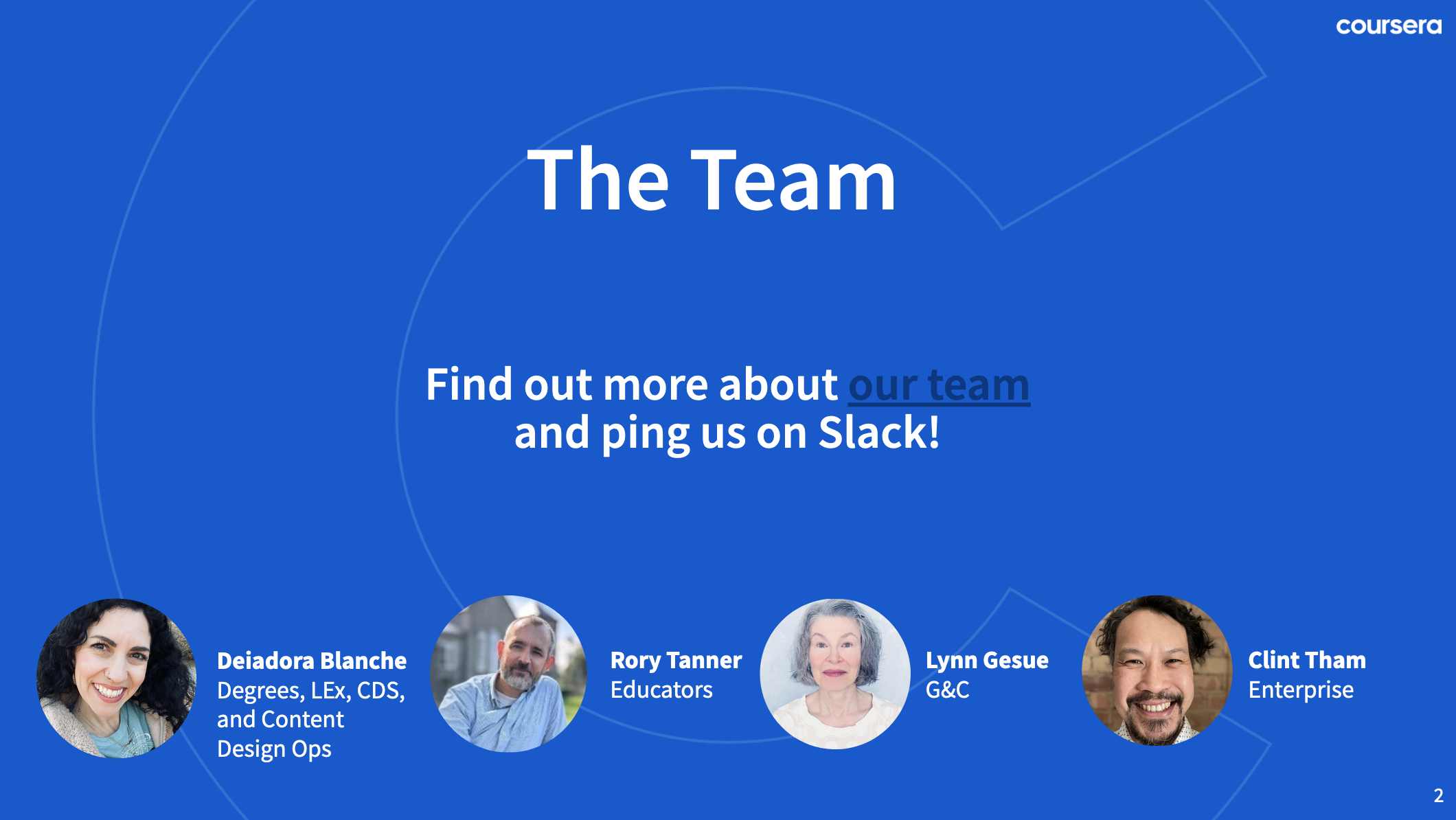Coursera: establishing content design
The challenge
Lead content design for 100+ desktop and mobile app projects spanning 4 verticals while laying a foundation for operations.
To scale content design processes and systems, I built a content design system embedded within our design system, content ops, content design workflows, and a content design collaboration model.
In 2 years, I set up content design to succeed at Coursera. Here’s how I did it.
SERVICES Content design ops, leadership and management, content strategy, information architecture, OOUX, UX research, product writing and editing, mentorship and education
PROJECT Establish the role and best practices of content design. Elevate the product’s content for all audiences.
STRATEGY Content ops, guidelines, and mentoring for IA and UX writing
RESULTS Increased learners from 78M to 100+M in less than 2 years.
Visit the site →
The solution
Content ops playbook
Next, I observed the culture and asked a fellow content designer about her needs and pain points. From there, I was able to write a playbook to help us collaborate with other functions. I kept this up to date as we evolved and our team grew.
Outlined what content designers do and what we deliver
Established engagement model and content governance
Gathered resources and made reusable templates for the team
Content design system
First on the list of ops to-do’s: include content guidelines in the Coursera Design System (CDS) used by all cross-functional partners.
Researched competitors and put together a list of components
Audited every vertical to make holistic styling decisions for formatting, numbers, and punctuation
Observed first-hand experiences and wrote principles for all Courserians to follow
Edited and kept 40~ components and 20~ pages of content guidelines up to date
Content design workflow
After a few months, I brought content designers, designers, design managers, researchers, and data scientists together to define our design process.
Led 2 workshops with 20+ cross-functional partners to co-create a design process workflow
Extended content’s workflow and added details for meetings, reviews, resources, tasks, and deliverables
Used the workflow to define project strategies and support collaboration
Engagement model
Helping with the interviewing process, our team grew to 4. Since our culture centered around slide decks, I created one to introduce us as a team.
Introduced who were were, what teams we worked on, and how to collaborate with us for multiple functions
Included the herstory of content design, what tasks we undertake, what we deliver, and its impact
Advocated for its inclusion during onboarding
Shared out when added to a new team or project
Content ops
Going beyond content ops
While it was imperative that I set up content ops at Coursera to ensure that we could scale as a team, I also supported 5 teams in different capacities: leader, contributor, and advisor.
In my leadership role, I provided content design support throughout the design process. From research and testing to UX writing and quality assurance testing, I led various projects to make a big impact.
As a contributor, I offered specific services during 2 or more phases in the design process. These were smaller projects on a tight timeline.
To allow the quality of the content to scale efficiently, I offered a weekly office hour and always kept my Slack open for quick feedback and recommendations. This made it possible for my fellow coworkers to learn about content design and become advocates themselves.
Content design as an IC
In my 2 years at Coursera, I was able to lead the content design on projects that touched on all learners (consumer, degree, and enterprise), educators and university partners, and enterprise admin.
This included content for marketing landing pages, marketing and transactional emails, onboarding flows, degree application forms, loading states, error messaging matrices, notifications, mobile (iOS and Android), and so much more.
Ask me about
59 transactional and upsell emails for Coursera for Business and the email template that it inspired across all products
The educator admin navigation “jobs to be done” revamp that spanned 4 partner audiences
SkillSets, LevelSets, and Skills content patterns that spanned 2 audiences and across multiple user flows





